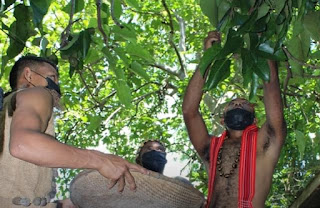Ata Tribe of Negros Oriental
The Philippines' status as an archipelago reveals a lot about its diversity as seen in various cultural and social groups composing it. Some are no longer around, while others are still thriving to exist. The various are collectively linked to the lands and natural resources of the nation's indigenous peoples based on where they reside. As a native of Negros Island, it is an honor for me to feature one of the various indigenous peoples’ groups in the Philippines, specifically the ones that are principally concentrated in the islands of Boracay, Panay, and Negros, the Ata Tribe. A documentary showcasing Brgy. Canggohob of Mabinay, Negros Oriental, where a group of Indigenous People named the Ata/Aeta Tribe is residing. The documentary focuses on the products that the Ata tribe produces, how these products are made and how their production of such products helped them survive as well as how they adapted to modern lifestyles and what they are doing to keep their traditions alive.
The Ata Tribe cherishes a specific tree as their treasure, named the Lumbang Tree. Generations of the tribe have passed on the importance of preserving and protecting the lumbang trees as they continue to benefit from them. Even before, the Ata tribe made use of the trees as a source of light by making a torch to light them up during the night. As time goes by, the uses of the lumbang trees have also evolved. Nowadays, the Ata tribe realized that the lumbang trees are more than just a tool to light up their night. It can now be used to produce various beautiful accessories. The tribe awaits the time of harvest when the seeds of the lumbang trees start to grow, waiting for the right time to collect and gather the seeds so they could prepare them for processing.
The lumbang seed processing starts with collecting seeds from the trees, then every single seed goes through the tribe’s own way of quality control. They tediously inspect every seed whether it will proceed to the next step of the process. After the seeds are filtered out, all the seeds are dried out under the heat of the sun. Once the seeds are all dried, the next step is to put holes on each side of every seed, and after that, a thorough polishing process comes next to achieve a smooth texture. The process of preparing seeds ends and proceeds to the making of designs. They poke it with a thread to make it either a necklace, bracelet, or any other design they can make from all the seeds that have gone through the said process.
Aside from farming and planting vegetables, every single member of the Ata Tribe takes part in the process of producing Lumbang products to sell not only as their way of earning an income and aid them in making a living but most especially as their way of preserving something their tribe considers a special thing that binds them as one from one generation to another. Hence, with all those in mind, it is needless to say that all of us should also take part in preserving the tribes left in the present times by supporting them as they thrive to survive.
HUM108B Final Output
Submitted by: Phoebe N. Sedillo
Documentary Link: https://www.youtube.com/watch?v=dqJjCsgGtxw














Comments
Post a Comment